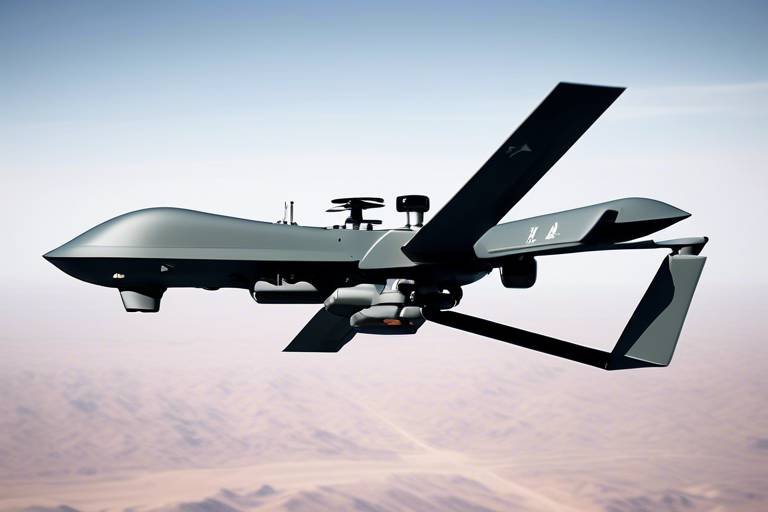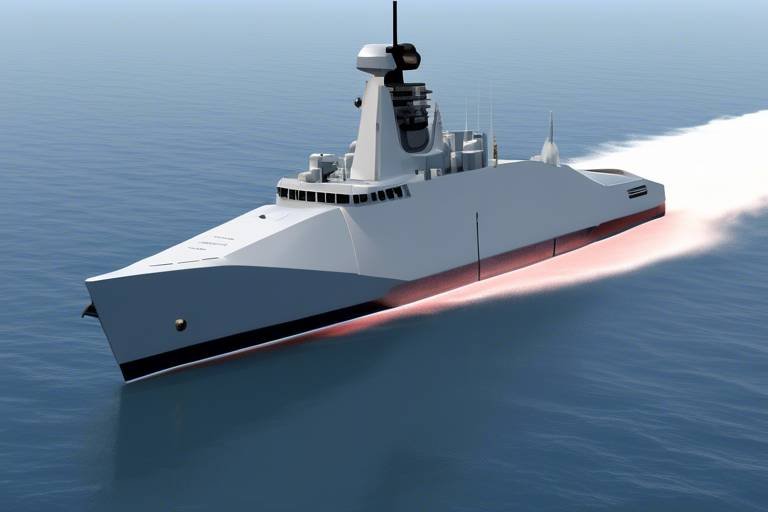AI in Remote Weapon Systems - Enhancing Precision
In today's rapidly evolving military landscape, the integration of artificial intelligence (AI) into remote weapon systems is not just a trend; it’s a revolutionary shift that enhances precision and effectiveness on the battlefield. Imagine a scenario where machines can analyze vast amounts of data in real time, making split-second decisions that could mean the difference between mission success and failure. This is not science fiction; it’s the reality of modern warfare, where AI is redefining how military operations are conducted. As we delve deeper into this topic, we will explore how AI enhances targeting accuracy, improves operational efficiency, and raises important ethical considerations.
Artificial intelligence has become a cornerstone of military technology, transforming traditional combat scenarios into highly sophisticated operations. At its core, AI refers to the simulation of human intelligence processes by machines, particularly computer systems. These processes include learning, reasoning, and self-correction. In military applications, AI can analyze data from various sources such as satellites, drones, and ground sensors, providing commanders with actionable insights that were previously unimaginable. This capability not only enhances situational awareness but also supports decision-making processes in high-stakes environments.
One of the most significant advantages of integrating AI into remote weapon systems is the remarkable improvement in targeting accuracy. Traditional targeting methods often rely heavily on human judgment, which can be prone to errors. AI, on the other hand, enhances precision by analyzing vast datasets, identifying patterns, and predicting outcomes. This reduction in human error is crucial, especially when the stakes are as high as they are in military operations. With AI, munitions are more likely to hit their intended targets, which not only saves resources but also minimizes collateral damage.
AI systems employ advanced data analysis techniques that allow them to process intelligence in real time. This capability is vital in complex environments where conditions can change rapidly. For instance, AI can analyze weather patterns, enemy movements, and terrain features simultaneously, providing a comprehensive view of the battlefield. By leveraging these insights, military personnel can make informed targeting decisions, ensuring that every shot counts. The ability to quickly adapt to new information is what sets AI apart from traditional methods.
At the heart of AI’s effectiveness in targeting systems are machine learning algorithms. These algorithms learn from past engagements, continuously refining their accuracy and adapting strategies based on new data inputs and outcomes. Imagine a system that gets smarter with every use, learning which tactics worked and which didn't. This iterative learning process not only enhances targeting precision but also allows for the development of predictive models that anticipate enemy actions.
Another critical component of AI's role in enhancing precision is sensor fusion. This technology combines data from multiple sensors—such as radar, infrared, and visual cameras—creating a comprehensive picture of the battlefield. By integrating data from diverse sources, AI systems can make accurate and timely targeting decisions. For example, in a high-pressure combat situation, sensor fusion enables operators to quickly assess threats and engage targets with unprecedented speed and accuracy.
Despite the numerous advantages that AI brings to remote weapon systems, there are challenges that must be addressed. Ethical concerns about the use of AI in warfare, technological limitations, and the necessity for robust cybersecurity measures are just a few of the hurdles that military organizations face. As we embrace this technology, it is essential to navigate these challenges thoughtfully to ensure that AI enhances, rather than complicates, military operations.
AI is not only about improving precision; it also plays a vital role in enhancing operational efficiency. By automating routine tasks, AI allows military personnel to focus on strategic decision-making. This automation is crucial in high-pressure environments where every second counts. For instance, AI can handle data processing and target identification, freeing operators to concentrate on mission-critical decisions.
The automation of targeting processes streamlines operations, significantly reducing engagement times. In combat scenarios, where decisions must be made quickly, the cognitive load on operators can be overwhelming. AI alleviates this burden, allowing military personnel to react swiftly and effectively. By automating these processes, military forces can engage targets faster and with greater confidence, ultimately leading to better outcomes on the battlefield.
Moreover, AI systems excel in optimizing resource allocation. By analyzing mission parameters and available assets, AI ensures that military operations are conducted with maximum efficiency and minimal waste. This optimization is akin to having a personal assistant that knows exactly how to allocate your time and resources for the best results. In military contexts, this means better planning, reduced costs, and more successful missions.
While the benefits of AI in remote weapon systems are compelling, they also raise significant ethical questions. Issues such as accountability for AI-driven decisions, the potential for unintended consequences, and the risk of autonomous warfare must be carefully considered. As we integrate AI into military operations, it’s vital to maintain a dialogue about these ethical implications to ensure responsible use of technology.
Determining accountability for decisions made by AI systems is a complex issue. In military engagements, understanding who is responsible for AI-driven actions—whether it be the developers, operators, or the military organization—requires careful consideration of legal and moral implications. This accountability is crucial in maintaining public trust and ensuring that military operations adhere to ethical standards.
Another pressing concern is the prevention of fully autonomous weapons systems. Many ethicists and military leaders emphasize the need for human oversight in critical combat decisions. The idea of machines making life-and-death decisions without human intervention raises alarm bells. Therefore, establishing guidelines and frameworks for the use of AI in warfare is essential to prevent the emergence of autonomous warfare.
- What are remote weapon systems? Remote weapon systems are weapon platforms that can be operated from a distance, often using AI and automation to enhance targeting and engagement capabilities.
- How does AI improve targeting accuracy? AI improves targeting accuracy by analyzing large datasets, reducing human error, and enabling real-time decision-making.
- What are the ethical concerns surrounding AI in warfare? Ethical concerns include accountability for AI decisions, the potential for unintended consequences, and the risk of autonomous warfare.
- Can AI systems operate independently in combat? While AI can assist in decision-making, there is a strong emphasis on maintaining human oversight to ensure ethical and responsible use of technology.

Understanding AI in Military Applications
Artificial Intelligence (AI) is revolutionizing the way military operations are conducted, and its impact is being felt across various domains. At its core, AI refers to the simulation of human intelligence in machines that are programmed to think like humans and mimic their actions. In military applications, AI is increasingly being used to enhance decision-making processes, improve operational efficiency, and ensure greater safety for personnel on the battlefield.
One of the most significant benefits of integrating AI into military technology is its ability to process vast amounts of data at unprecedented speeds. Imagine a soldier on the ground, trying to assess a rapidly changing battlefield scenario. With AI, data from various sources—such as drones, satellite imagery, and reconnaissance reports—can be analyzed in real-time, providing commanders with a clearer and more comprehensive picture of the situation. This capability not only aids in strategic planning but also enhances situational awareness, allowing for quicker and more informed decisions.
Moreover, AI can help minimize human error, which is often a critical factor in military engagements. Traditional decision-making processes can be influenced by fatigue, stress, and cognitive overload, especially in high-pressure environments. AI systems, however, operate without such limitations, enabling them to analyze data and suggest optimal actions based on algorithms and historical data. This leads to improved outcomes in combat scenarios, as decisions are made based on accurate data rather than human judgment alone.
As we delve deeper into the role of AI in military applications, it’s essential to recognize the various areas where it is making a significant impact:
- Enhanced Surveillance: AI-powered systems can monitor vast areas and detect unusual activities, providing early warnings and allowing for proactive measures.
- Predictive Analytics: By analyzing historical data, AI can forecast potential threats and suggest preemptive actions.
- Logistics Management: AI optimizes supply chains and resource allocation, ensuring that troops have what they need when they need it.
In summary, the integration of AI into military applications is not just a trend; it's a transformative shift that enhances precision, safety, and operational efficiency. As technology continues to evolve, the possibilities for AI in military contexts are virtually limitless, paving the way for a new era of warfare where data-driven decisions can significantly alter the outcome of engagements.
- What is the primary role of AI in military applications? AI enhances decision-making, improves operational efficiency, and increases safety by processing large amounts of data quickly and accurately.
- How does AI minimize human error in military operations? AI systems operate without the cognitive limitations of humans, providing data-driven recommendations that reduce the chances of mistakes caused by fatigue or stress.
- What are some examples of AI applications in the military? AI is used in surveillance, predictive analytics, logistics management, and automated targeting systems.

Improving Targeting Accuracy
In the realm of modern warfare, targeting accuracy is paramount. Gone are the days when soldiers relied solely on their instincts and rudimentary tools to hit their marks. Today, the integration of artificial intelligence (AI) into remote weapon systems has revolutionized how military operations approach precision targeting. By harnessing the power of AI, military forces can analyze vast amounts of data, which significantly reduces the risk of human error and enhances the likelihood that munitions will strike their intended targets with unparalleled accuracy.
One of the most significant advantages of AI in targeting is its ability to process information in real-time. Imagine a scenario where a military unit is operating in a complex environment with multiple moving parts. AI systems can sift through an ocean of data from various sources, such as satellite imagery, drone feeds, and ground sensors, to create a detailed picture of the battlefield. This capability not only improves situational awareness but also enables commanders to make more informed decisions regarding targeting. The result? A dramatic increase in the chances of hitting the right target while minimizing collateral damage.
Advanced data analysis techniques employed by AI are key to improving targeting accuracy. These techniques allow for the rapid processing of intelligence, which is essential in dynamic combat scenarios. For instance, AI can analyze patterns in enemy movements, predict their next steps, and suggest optimal engagement strategies. This level of analysis is akin to having a seasoned strategist at your side, constantly evaluating the battlefield and providing insights that can turn the tide of a conflict.
At the heart of these data analysis techniques are machine learning algorithms. These algorithms learn from past engagements, adapting strategies based on new data inputs and outcomes. For example, if an AI system identifies that a particular type of munition has a higher success rate against a specific target type, it will adjust its recommendations accordingly. This continuous learning process ensures that military operations are not only reactive but also proactive, anticipating challenges before they arise.
Sensor fusion is another critical component in enhancing targeting accuracy. By combining data from multiple sensors—such as infrared, radar, and visual feeds—AI systems can create a comprehensive and cohesive view of the battlefield. This fusion of information is essential for making accurate and timely targeting decisions, especially in environments where visibility may be compromised. Think of it as piecing together a jigsaw puzzle; each piece of data contributes to a clearer picture, allowing operators to engage targets with confidence.
Despite the numerous advantages, the implementation of AI in remote weapon systems is not without its challenges. Ethical concerns, technological limitations, and the need for robust cybersecurity measures are just a few obstacles that military forces must navigate. As we embrace this new era of warfare, it is crucial to address these issues to ensure that the benefits of AI in improving targeting accuracy are fully realized while maintaining the integrity of military operations.
- How does AI improve targeting accuracy in military operations?
AI enhances targeting accuracy by analyzing large volumes of data in real-time, reducing human error, and providing informed recommendations based on past engagements. - What are machine learning algorithms?
Machine learning algorithms are systems that learn from data inputs, adapting their strategies based on previous outcomes to improve future performance. - What is sensor fusion?
Sensor fusion is the process of combining data from multiple sensors to create a comprehensive view of the battlefield, aiding in accurate targeting decisions. - What challenges exist in implementing AI in weapon systems?
Challenges include ethical concerns, technological limitations, and the need for strong cybersecurity measures to protect sensitive data.

Data Analysis Techniques
In the realm of modern warfare, the integration of artificial intelligence into remote weapon systems is nothing short of revolutionary. One of the key components that enables this transformation is advanced . These techniques are essential for processing vast amounts of information in real time, which significantly enhances situational awareness on the battlefield. Imagine trying to find a needle in a haystack; now, picture AI as a powerful magnet that not only locates the needle but also analyzes its surroundings to determine the best way to extract it. This is the essence of what AI does in military applications.
AI systems utilize a plethora of data sources, such as satellite imagery, reconnaissance reports, and sensor data, to create a comprehensive operational picture. By employing sophisticated algorithms, these systems can sift through and analyze data at speeds that far exceed human capabilities. For instance, AI can identify patterns and anomalies in data that might elude even the most experienced analysts. This capability is crucial in combat scenarios where every second counts, and decisions must be made swiftly and accurately.
One of the most effective techniques in AI-driven data analysis is predictive analytics. This involves using historical data to forecast future events. By analyzing past engagements, AI can identify trends and predict enemy movements, thereby providing military commanders with a tactical edge. Furthermore, the application of real-time data processing means that as new information becomes available, AI systems can adjust their predictions and recommendations instantly, ensuring that military personnel are always equipped with the most relevant information.
Another vital aspect of AI data analysis is the use of machine learning algorithms. These algorithms allow AI systems to learn from previous engagements and improve over time. For example, if a targeting system consistently misidentifies a particular type of target, the machine learning algorithm can adapt its parameters based on the feedback received, leading to improved accuracy in future operations. This iterative learning process is akin to how a seasoned soldier hones their skills through experience, making AI a continually evolving asset on the battlefield.
Moreover, sensor fusion plays a pivotal role in enhancing data analysis. This technique involves the integration of data from multiple sensors to create a unified and detailed view of the operational environment. By combining information from ground sensors, aerial surveillance, and even human intelligence, AI can construct a more accurate battlefield representation. This holistic approach enables timely and precise targeting decisions, reducing the likelihood of collateral damage and increasing mission success rates.
In summary, the data analysis techniques employed by AI in remote weapon systems are not just about crunching numbers; they represent a fundamental shift in how military operations are conducted. By leveraging advanced analytics, predictive modeling, and sensor fusion, AI empowers military personnel to make informed decisions faster and with greater accuracy than ever before. As we continue to explore the potential of AI in warfare, it is clear that the future of military operations will be deeply intertwined with these innovative data analysis techniques.
- What is the role of AI in military operations? AI enhances decision-making, improves targeting accuracy, and increases operational efficiency by analyzing vast amounts of data.
- How does predictive analytics improve combat strategies? Predictive analytics uses historical data to forecast enemy movements and trends, allowing for better tactical planning.
- What is sensor fusion? Sensor fusion is the process of integrating data from multiple sources to create a comprehensive picture of the battlefield.
- Are there ethical concerns regarding AI in warfare? Yes, there are significant ethical considerations, particularly regarding accountability and the potential for autonomous decision-making in combat.

Machine Learning Algorithms
Machine learning algorithms are the backbone of modern AI systems, especially when it comes to enhancing the precision of remote weapon systems. These algorithms are designed to learn from data, adapt to new information, and improve their performance over time. Imagine having a system that not only remembers past engagements but also analyzes the outcomes to refine its targeting strategies. This is precisely what machine learning brings to the table. It’s like a soldier who learns from every mission, becoming more adept and efficient with each experience.
One of the primary advantages of machine learning in military applications is its ability to process vast amounts of data quickly. In the chaotic environment of warfare, where decisions must be made in fractions of a second, having a system that can analyze and interpret data in real-time is invaluable. For instance, algorithms can sift through intelligence reports, satellite imagery, and sensor data to identify patterns and anomalies that human operators might miss. This capability not only enhances situational awareness but also significantly reduces the likelihood of human error, which can be catastrophic in combat scenarios.
Moreover, machine learning algorithms can be categorized into several types, each serving unique functions in remote weapon systems. These include:
- Supervised Learning: This involves training algorithms on labeled datasets, allowing them to learn from examples. In a military context, this could mean using historical data of successful and unsuccessful strikes to improve future targeting algorithms.
- Unsupervised Learning: Unlike supervised learning, this method identifies patterns in data without predefined labels. It can help in discovering hidden relationships in battlefield data, such as identifying enemy movements based on sensor inputs.
- Reinforcement Learning: This approach allows algorithms to learn optimal actions through trial and error. In remote weapon systems, reinforcement learning can help refine targeting strategies by rewarding successful hits and penalizing misses, ultimately leading to improved accuracy over time.
As these algorithms evolve, they become more adept at predicting outcomes based on various scenarios. For example, they can assess the effectiveness of different munitions against specific targets, taking into account factors like distance, weather conditions, and terrain. This level of analysis is akin to having a tactical advisor who can provide real-time recommendations based on the current battlefield dynamics.
However, the integration of machine learning algorithms into remote weapon systems is not without challenges. The complexity of these algorithms necessitates robust data management and cybersecurity measures to prevent potential exploitation by adversaries. Additionally, the reliance on machine learning raises questions about the transparency of decision-making processes in military operations. How do we ensure that operators understand and trust the recommendations made by AI systems? This is a critical consideration that military leaders must address as they implement these technologies.
In conclusion, machine learning algorithms are revolutionizing the way military forces engage in combat. By enhancing targeting precision and operational efficiency, they are not just tools of war; they are transforming the very nature of military strategy. As we continue to explore the potential of AI in warfare, the implications of these advancements will undoubtedly shape the future of military operations.
- What are machine learning algorithms? Machine learning algorithms are computational models that learn from data to make predictions or decisions without being explicitly programmed for specific tasks.
- How do machine learning algorithms improve military operations? They enhance targeting accuracy, reduce human error, and enable real-time data analysis, leading to more informed decision-making in combat scenarios.
- What are the challenges of using machine learning in warfare? Challenges include ethical concerns, the need for transparency in AI decision-making, and ensuring robust cybersecurity to protect sensitive data.

Sensor Fusion
In the ever-evolving landscape of military technology, stands out as a transformative approach that significantly enhances the capabilities of remote weapon systems. At its core, sensor fusion is the process of integrating data from multiple sensors to create a cohesive and comprehensive understanding of the battlefield environment. Imagine trying to piece together a complex jigsaw puzzle; each sensor acts like a unique puzzle piece, and when combined, they reveal a clearer picture of the operational landscape.
One of the primary advantages of sensor fusion is its ability to provide real-time situational awareness. By synthesizing information from various sources—such as radar, infrared, and optical sensors—AI systems can generate an accurate representation of potential threats and targets. This holistic view is crucial for military operators who need to make split-second decisions in high-pressure situations. For instance, if a remote weapon system detects an incoming threat, the fused data can help determine its trajectory, speed, and potential impact, allowing for timely and precise countermeasures.
Moreover, the integration of sensor fusion not only enhances targeting accuracy but also reduces the cognitive burden on operators. In chaotic combat scenarios, the sheer volume of data can be overwhelming. By employing advanced algorithms that prioritize and filter information, sensor fusion enables operators to focus on the most critical aspects of the mission. This streamlined decision-making process is akin to having a highly skilled assistant who filters through mountains of information to present only what is necessary for effective action.
However, the implementation of sensor fusion is not without its challenges. The complexity of integrating diverse data sources requires sophisticated algorithms and robust computing power. Additionally, the reliability of the fused data is paramount; if one sensor provides inaccurate information, it can skew the entire operational picture. To mitigate these risks, military organizations invest heavily in testing and validation processes, ensuring that the systems can perform effectively under various conditions.
In summary, sensor fusion is a game-changer in the realm of remote weapon systems. By combining data from multiple sensors, it enhances situational awareness, improves targeting accuracy, and reduces the cognitive load on operators. As military technology continues to advance, the role of sensor fusion will likely expand, paving the way for even more sophisticated and effective combat strategies.
- What is sensor fusion? Sensor fusion is the integration of data from multiple sensors to create a comprehensive understanding of an environment, particularly useful in military applications.
- How does sensor fusion improve targeting accuracy? By synthesizing information from various sensors, sensor fusion provides a clearer picture of potential threats, enabling more precise targeting decisions.
- What are the challenges of implementing sensor fusion? Challenges include the need for advanced algorithms, robust computing power, and ensuring the reliability of the integrated data.
- Why is real-time situational awareness important? Real-time situational awareness allows military operators to make informed decisions quickly, which is crucial in high-pressure combat situations.

Challenges in Implementation
As we dive deeper into the integration of AI in remote weapon systems, it's essential to recognize that the journey is not without its bumps. While the advantages are clear, the are equally significant and deserve our attention. One of the foremost issues is the ethical concerns surrounding the use of AI in military operations. Imagine a scenario where a machine makes life-and-death decisions without human intervention. This raises profound questions about accountability and the moral implications of such actions.
Moreover, the technology itself is not infallible. Technological limitations present another hurdle; AI systems require vast amounts of data to function effectively, and the quality of this data is paramount. Inaccurate or biased data can lead to disastrous outcomes, which could potentially escalate conflicts rather than resolve them. The challenge here is ensuring that the data fed into these systems is both comprehensive and representative of real-world complexities.
Another significant concern is cybersecurity. As military operations increasingly rely on AI, the risk of cyberattacks grows. A breach could compromise not only the weapon systems but also the entire operational framework, leading to catastrophic results. Therefore, robust cybersecurity measures are not just an option; they are a necessity. This involves not only protecting the systems themselves but also training personnel to recognize and respond to potential threats.
To summarize, the challenges in implementing AI in remote weapon systems can be categorized into three main areas:
- Ethical Concerns: The moral implications of AI decision-making in combat situations.
- Technological Limitations: The dependency on accurate data and the risks of bias.
- Cybersecurity Threats: The necessity for robust defenses against potential cyberattacks.
In conclusion, while the potential benefits of AI in military applications are immense, the challenges cannot be overlooked. Addressing these issues requires a collaborative effort among military leaders, ethicists, and technologists to ensure that the deployment of AI enhances operational effectiveness without compromising ethical standards or security.
- What are the main ethical concerns regarding AI in military applications?
The primary ethical concerns involve accountability for AI decisions, the potential for autonomous warfare, and the moral implications of machines making life-and-death choices. - How does data quality affect AI targeting systems?
The effectiveness of AI systems heavily relies on the quality of data. Inaccurate or biased data can lead to poor decision-making and unintended consequences in combat scenarios. - What cybersecurity measures are necessary for AI systems in the military?
Robust cybersecurity measures must include protecting the systems from breaches, regular security audits, and training personnel to recognize and respond to cyber threats.

Enhancing Operational Efficiency
In the fast-paced world of modern warfare, operational efficiency is not just a luxury; it's a necessity. The integration of artificial intelligence (AI) into remote weapon systems is revolutionizing how military operations are conducted, making them faster, smarter, and more effective. Imagine a battlefield where decisions are made in the blink of an eye, and resources are allocated with pinpoint accuracy. This is the new reality that AI brings to the table.
One of the most significant contributions of AI is the automation of targeting processes. Traditional targeting methods can be slow and cumbersome, often requiring human operators to sift through mountains of data before making a decision. With AI, this process is streamlined. AI systems can analyze data in real-time, allowing for quicker engagement times. This is crucial in high-pressure combat situations where every second counts. Operators can focus on strategy rather than getting bogged down in the minutiae of data analysis.
Moreover, AI enhances operational efficiency by optimizing resource allocation. In military operations, it's not just about having the right tools; it's about using them effectively. AI systems can analyze mission parameters and available assets, ensuring that military forces are deployed in the most effective manner. For instance, consider a scenario where multiple units are engaged in different operations. An AI system can assess which unit requires additional support and allocate resources accordingly, thereby maximizing the effectiveness of the entire operation.
To illustrate this point further, let's look at a simple table that outlines how AI impacts resource allocation:
| Aspect | Traditional Approach | AI-Enhanced Approach |
|---|---|---|
| Data Processing | Manual analysis of data | Real-time data analysis |
| Decision Time | Hours or days | Seconds to minutes |
| Resource Allocation | Static and often inefficient | Dynamic and optimized |
By automating these processes, AI not only reduces the cognitive load on operators but also enhances the overall effectiveness of military engagements. Imagine being in a high-stakes situation where you can trust that your AI system is handling routine tasks, allowing you to concentrate on making critical decisions. This kind of operational efficiency can mean the difference between success and failure on the battlefield.
However, it's essential to recognize that while AI significantly enhances operational efficiency, it doesn't eliminate the need for human oversight. The technology is a tool that complements human decision-making, rather than replacing it. The best outcomes in military operations arise from a harmonious blend of human intuition and AI capabilities.
- What role does AI play in military operations? AI enhances decision-making, automates processes, and optimizes resource allocation in military operations.
- How does AI improve targeting accuracy? AI analyzes vast amounts of data quickly, reducing human error and ensuring more precise targeting.
- Are there ethical concerns with using AI in warfare? Yes, ethical concerns include accountability for AI decisions and the potential for autonomous warfare.
- Can AI completely replace human operators in military settings? No, AI serves as a tool to assist human operators, but human oversight is crucial for effective decision-making.

Automation of Targeting Processes
In the fast-paced world of modern warfare, automation has become a game-changer, especially in the realm of targeting processes. Imagine a scenario where military personnel can focus on strategic decisions rather than getting bogged down by the minutiae of targeting. This is where AI steps in, revolutionizing the way targets are identified and engaged. By automating these processes, AI not only speeds up engagement times but also significantly reduces the cognitive load on operators. In high-pressure combat situations, this can be the difference between success and failure.
One of the most remarkable aspects of automated targeting is its ability to process vast amounts of data in real-time. AI systems are designed to analyze information from various sources, including satellite imagery, drone feeds, and battlefield reports. This capability allows for quicker and more accurate targeting decisions. For instance, if a military unit is monitoring a conflict zone, the AI can sift through hundreds of data points, identifying potential threats and presenting them to human operators with actionable intelligence.
Moreover, automation minimizes the risk of human error, which can have catastrophic consequences in combat scenarios. By relying on AI to handle routine targeting tasks, military personnel can dedicate their mental resources to more complex strategic planning. This shift not only enhances operational efficiency but also improves overall mission success rates. Consider the following key benefits of automating targeting processes:
- Speed: Automation drastically reduces the time taken to identify and engage targets, allowing for rapid response in dynamic environments.
- Accuracy: AI systems improve targeting precision by eliminating human biases and errors, ensuring that munitions hit their intended targets.
- Focus: Operators can concentrate on higher-level strategies rather than getting lost in the details of target acquisition.
However, while the advantages of automation in targeting processes are clear, it’s crucial to recognize the potential challenges as well. For example, the reliance on automated systems raises questions about the robustness of the technology. What happens if the AI misidentifies a target? Or if it fails to process data accurately due to a technical glitch? These concerns highlight the importance of maintaining human oversight in the targeting process, ensuring that automated systems serve as tools to enhance human decision-making rather than replace it entirely.
In conclusion, the automation of targeting processes stands as a testament to the transformative power of AI in military operations. By streamlining the identification and engagement of targets, AI not only enhances operational efficiency but also empowers military personnel to make more informed, strategic decisions. As we continue to explore the integration of AI in remote weapon systems, the balance between automation and human oversight will be critical in shaping the future of warfare.
- What is the role of AI in military targeting processes?
AI enhances the speed and accuracy of target identification and engagement, allowing military personnel to focus on strategic decisions. - How does automation reduce human error in targeting?
By relying on AI systems to analyze data and make decisions, the potential for human biases and mistakes is significantly minimized. - Can automated systems operate without human oversight?
While automation can streamline processes, maintaining human oversight is crucial to ensure accountability and prevent errors.

Resource Allocation Optimization
This article explores the integration of artificial intelligence in remote weapon systems, focusing on its impact on precision, safety, and operational efficiency in modern military applications.
This section delves into the basics of artificial intelligence and its growing role in military technology, highlighting the benefits it brings to combat scenarios and decision-making processes.
AI enhances targeting accuracy in remote weapon systems by analyzing vast amounts of data, reducing human error, and ensuring that munitions hit their intended targets with greater precision.
Advanced data analysis techniques employed by AI systems allow for real-time processing of intelligence, improving situational awareness and enabling more informed targeting decisions in complex environments.
Machine learning algorithms play a crucial role in refining targeting systems by learning from past engagements and adapting strategies based on new data inputs and outcomes.
Sensor fusion combines data from multiple sources to create a comprehensive picture of the battlefield, aiding AI systems in making accurate and timely targeting decisions.
Despite the advantages, the implementation of AI in remote weapon systems faces challenges, including ethical concerns, technological limitations, and the need for robust cybersecurity measures.
AI contributes to operational efficiency by automating routine tasks, allowing military personnel to focus on strategic decision-making and reducing the time required to engage targets effectively.
Automation streamlines the targeting process, enabling faster engagement times and reducing the cognitive load on operators, which is crucial in high-pressure combat situations.
Resource allocation optimization is a vital aspect of military operations, especially when it comes to maximizing the impact of limited assets. AI systems are designed to analyze various mission parameters, such as troop strength, equipment availability, and environmental factors, to ensure that resources are allocated efficiently. Imagine a chess game where every piece has a specific role; AI acts as the grandmaster, making strategic decisions that enhance overall effectiveness.
By processing vast amounts of data, AI can predict the best course of action, ensuring that each unit is deployed where it can do the most good. For example, during a mission, AI can assess whether to deploy additional drones for reconnaissance or redirect ground troops based on real-time intelligence updates. This dynamic allocation not only conserves resources but also increases the likelihood of mission success.
Moreover, AI can identify patterns and trends in resource usage over time, providing insights that lead to better planning in future operations. This predictive capability allows military leaders to preemptively address potential shortages or surpluses of equipment and personnel, thus maintaining a strategic advantage. The following table illustrates how AI can optimize resource allocation by comparing traditional methods with AI-enhanced strategies:
| Aspect | Traditional Methods | AI-Enhanced Strategies |
|---|---|---|
| Data Processing | Manual analysis of reports | Real-time data processing |
| Decision Time | Hours to days | Minutes to seconds |
| Resource Utilization | Reactive adjustments | Proactive allocation |
| Outcome Prediction | Historical data trends | Predictive analytics |
In conclusion, the integration of AI in resource allocation not only streamlines operations but also empowers military leaders to make informed decisions swiftly. This capability is crucial in ensuring that every asset is utilized to its fullest potential, ultimately leading to more successful outcomes on the battlefield.
The use of AI in remote weapon systems raises significant ethical questions about accountability, decision-making in combat, and the potential for unintended consequences in warfare.
Determining accountability for decisions made by AI systems is a complex issue that requires careful consideration of legal and moral implications in military engagements.
Preventing the development of fully autonomous weapons systems is a key concern among ethicists and military leaders, emphasizing the need for human oversight in critical combat decisions.
- What is AI's role in military operations? AI enhances decision-making, targeting accuracy, and operational efficiency by analyzing data and automating processes.
- How does AI improve targeting accuracy? AI analyzes vast amounts of data to reduce human error and ensure munitions hit their intended targets.
- What are the ethical concerns surrounding AI in warfare? Key concerns include accountability for AI decisions and the risk of autonomous warfare.
- Can AI systems predict future resource needs? Yes, AI can analyze patterns in resource usage to help military leaders plan for future operations effectively.

Ethical Considerations of AI in Warfare
The integration of artificial intelligence (AI) into remote weapon systems is not just a technological revolution; it also brings forth a myriad of ethical considerations that military leaders, policymakers, and society must grapple with. As we stand on the precipice of a new era in warfare, the questions surrounding accountability, decision-making, and the potential for unintended consequences become increasingly pressing. Can we trust machines to make life-and-death decisions? What happens when an AI system misinterprets a target? These are not just hypothetical scenarios; they are real concerns that demand our attention.
One of the most significant ethical dilemmas is related to accountability. When an AI system makes a decision that leads to civilian casualties or a military blunder, who is responsible? Is it the programmer, the military commander, or the AI itself? This complex web of accountability necessitates a thorough examination of legal and moral implications. We find ourselves at a crossroads where traditional frameworks of responsibility may not apply. As AI systems become more autonomous, the question of who is liable for their actions becomes murky.
Moreover, the potential for autonomous warfare raises alarms among ethicists and military leaders alike. The fear is that, if left unchecked, AI could lead to systems that operate independently of human oversight. This scenario could result in machines making decisions based on algorithms devoid of human empathy or moral judgment. The call for strict regulations and guidelines to prevent the development of fully autonomous weapons systems is louder than ever. It emphasizes the necessity for human involvement in critical combat decisions, ensuring that moral and ethical considerations remain at the forefront of military operations.
Additionally, the deployment of AI in warfare could inadvertently lead to a dehumanization of combat. When decisions about life and death are made by machines, it risks reducing the gravity of warfare to a mere data analysis problem. This shift could desensitize military personnel and society to the harsh realities of conflict, potentially leading to an increase in military engagements without fully comprehending the implications. As we navigate this new landscape, it is essential to maintain a balance between technological advancement and the preservation of humanity in warfare.
In summary, as we embrace the potential of AI in remote weapon systems, we must also remain vigilant about the ethical implications. The need for accountability, the prevention of autonomous warfare, and the preservation of human judgment in combat are critical issues that require ongoing dialogue and regulation. By addressing these considerations head-on, we can harness the benefits of AI while safeguarding our moral and ethical standards in military operations.
- What are the main ethical concerns regarding AI in warfare?
The primary concerns include accountability for decisions made by AI, the risk of autonomous warfare, and the potential dehumanization of combat.
- How can accountability be ensured when using AI in military operations?
Establishing clear legal frameworks and guidelines for AI usage, along with maintaining human oversight, can help ensure accountability.
- What measures can be taken to prevent fully autonomous weapons systems?
International regulations and treaties can be established to prohibit the development of fully autonomous weapons, ensuring that human oversight remains a key component in military decision-making.
- Why is human oversight important in AI-driven military systems?
Human oversight is crucial to ensure that ethical and moral considerations are taken into account, preventing machines from making decisions that could lead to unintended consequences.

Accountability in AI Decisions
The advent of artificial intelligence (AI) in military applications has sparked a significant debate about accountability for decisions made by these sophisticated systems. As AI takes on more roles in remote weapon systems, the question arises: who is responsible when an AI system makes a decision that leads to unintended consequences? This is not just a theoretical issue; it has real-world implications that could affect lives and international relations.
To unpack this complex issue, we must consider several factors. First, there’s the legal framework surrounding military operations. Traditionally, accountability in warfare has been attributed to human decision-makers. However, when an AI system autonomously engages a target, it blurs the lines of responsibility. Is it the programmer who designed the algorithm? The military personnel who deployed the system? Or is it the AI itself, which lacks the ability to understand the moral implications of its actions? This ambiguity raises urgent questions about how we define accountability in the context of AI.
Moreover, ethical considerations complicate this further. The moral responsibility for decisions made in combat situations has always rested with humans, who can weigh the consequences of their actions. AI, on the other hand, operates based on data and algorithms, devoid of human emotions or ethical considerations. This lack of judgment could lead to decisions that, while statistically sound, may not align with humanitarian principles. For instance, if an AI system misidentifies a civilian target as a combatant, the consequences could be catastrophic. Who bears the blame in such a scenario?
Additionally, the potential for malfunction or bias in AI systems adds another layer of complexity. AI algorithms are trained on data, and if that data is flawed or biased, the decisions made by the system may also be flawed. This highlights the need for rigorous testing and validation of AI systems before they are deployed in combat. Military leaders must ensure that AI systems are not only effective but also ethical in their operations.
To address these challenges, some experts advocate for the establishment of clear guidelines and regulations governing the use of AI in military contexts. This could include:
- Mandatory human oversight for critical decisions.
- Transparent algorithms that can be audited for bias and accuracy.
- Clear lines of accountability that designate responsibility in the event of an AI failure.
Ultimately, the question of accountability in AI decisions is not just a technical issue; it is a moral and ethical dilemma that society must grapple with as we move further into the age of artificial intelligence in warfare. Addressing these concerns will require collaboration between technologists, military leaders, ethicists, and policymakers to ensure that the deployment of AI in military operations is done responsibly and ethically.
- What happens if an AI system makes a mistake in combat?
Accountability can be complex, involving the developers, military personnel, and the systems themselves. - Are there regulations governing AI use in military operations?
Currently, there is a push for clearer guidelines, but regulations vary by country and are still evolving. - How can we ensure AI systems are ethical?
Through rigorous testing, transparent algorithms, and mandatory human oversight.

Preventing Autonomous Warfare
The emergence of autonomous weapon systems has sparked intense debates among ethicists, military leaders, and policymakers. These discussions revolve around the profound implications of allowing machines to make life-and-death decisions in combat scenarios. Imagine a battlefield where decisions are made not by humans but by algorithms—this prospect raises numerous ethical and practical concerns. How do we ensure that accountability remains intact when a machine fires a weapon? This question is at the forefront of discussions on preventing autonomous warfare.
One of the primary concerns is the potential for unintended consequences. Machines lack the moral and ethical reasoning that humans possess. In a dynamic combat environment, an autonomous system might misinterpret data, leading to catastrophic outcomes. For instance, if an AI system misidentifies a civilian as a threat, the consequences could be devastating. This highlights the critical need for human oversight in all military engagements involving AI.
Furthermore, the issue of accountability becomes increasingly complex when machines are involved in decision-making. If an autonomous weapon system causes collateral damage, who is responsible? The programmer? The military commander? Or the machine itself? These questions complicate the legal and moral frameworks within which military operations are conducted. To mitigate these risks, it is essential to develop strict guidelines governing the use of AI in warfare.
To address these challenges, many experts advocate for a hybrid approach that combines the strengths of AI with human judgment. This could involve using AI for data analysis and targeting assistance while ensuring that final decisions are made by trained personnel. Such a model could leverage the speed and efficiency of AI while maintaining the ethical considerations that human oversight provides.
Moreover, international regulations need to be established to prevent the proliferation of fully autonomous weapon systems. Just as there are treaties governing chemical and biological weapons, similar frameworks should be created for AI in warfare. These regulations would not only help in controlling the development of autonomous systems but also promote accountability and ethical standards across nations.
In conclusion, while AI has the potential to revolutionize military operations, it is imperative that we tread carefully. The prevention of autonomous warfare is not merely a technical challenge but a moral imperative. By ensuring that humans remain at the center of decision-making processes and establishing robust regulations, we can harness the benefits of AI while safeguarding our ethical responsibilities in warfare.
- What are autonomous weapon systems? Autonomous weapon systems are military systems that can select and engage targets without human intervention.
- Why is human oversight important in military AI? Human oversight is crucial to ensure ethical decision-making and accountability in combat situations.
- What are the risks of autonomous warfare? Risks include unintended consequences, lack of accountability, and potential violations of international law.
- How can we regulate autonomous weapons? Through international treaties and guidelines that establish ethical standards and accountability measures.
Frequently Asked Questions
- What is the role of AI in remote weapon systems?
AI plays a crucial role in enhancing the precision and efficiency of remote weapon systems. By analyzing vast amounts of data, AI helps to improve targeting accuracy, reduce human error, and streamline operational processes, ultimately leading to more effective military outcomes.
- How does AI improve targeting accuracy?
AI improves targeting accuracy by utilizing advanced data analysis techniques, such as machine learning algorithms and sensor fusion. These technologies allow AI systems to process real-time intelligence, learn from past engagements, and create a comprehensive battlefield picture, ensuring that munitions hit their intended targets.
- What are the challenges of implementing AI in military applications?
Implementing AI in military applications comes with several challenges, including ethical concerns regarding accountability in decision-making, technological limitations, and the necessity for robust cybersecurity measures to protect sensitive data and systems from potential threats.
- How does AI enhance operational efficiency in military operations?
AI enhances operational efficiency by automating routine tasks, which allows military personnel to focus on strategic decision-making. This automation leads to faster engagement times and optimizes resource allocation, ensuring that missions are conducted with maximum effectiveness and minimal waste.
- What ethical considerations arise from the use of AI in warfare?
The use of AI in warfare raises significant ethical questions, particularly regarding accountability for AI-driven decisions and the potential for unintended consequences. It is crucial to maintain human oversight in combat situations to prevent the development of fully autonomous weapon systems.
- How can accountability be ensured in AI decision-making?
Ensuring accountability in AI decision-making involves careful consideration of legal and moral implications. Military leaders and ethicists must establish clear guidelines and frameworks to determine responsibility for actions taken by AI systems during combat engagements.
- What measures can be taken to prevent autonomous warfare?
To prevent autonomous warfare, it is essential to emphasize the need for human oversight in critical combat decisions. Establishing international regulations and ethical standards can help mitigate the risks associated with the development of fully autonomous weapons systems.



















